- Home
- Keigo Higashino
Journey Under the Midnight Sun
Journey Under the Midnight Sun Read online
Praise for Keigo Higashino
‘Higashino offers one twist after another, all of which touch on the theme suggested by the book’s title. Readers will marvel at the artful way the plot builds to the solution of Hidaka’s murder’ Publishers Weekly on Malice
‘Keigo Higashino again proves his mastery of the diabolical puzzle mystery with Malice, a story with more turns, twists, switchbacks and sudden stops than a Tokyo highway during Golden Week’ New York Times on Malice
‘Keigo Higashino combines Dostoyevskian psychological realism with classic detective-story puzzles reminiscent of Agatha Christie and E.C. Bentley’ Wall Street Journal
‘Higashino continues to elevate the modern mystery as an intense and inventive literary form’ Library Journal
‘Intricate… At the outset, [Higashino’s] approach seems unsettling, but the Edgar nominee knows his business’ Booklist
‘Each time you’re convinced Higashino’s wrung every possible twist out of his golden-age setup, he comes up with a new one’ Kirkus Reviews
‘Intricate and beguiling… if you like riddles inside enigmas, it will please you no end’ Guardian on The Devotion of Suspect X
‘The plot is satisfyingly twisty and gathers pace as the revelations come thicker, faster, and more and more unexpected’ Sydney Morning Herald on Malice
‘Each time Higashino makes a revelation, he quickly pulls the carpet from under one’s feet, fuelling the reader to finish the book as quickly as possible’ Singapore Straits Times
Keigo Higashino was born in Osaka. He started writing novels while still working as an engineer at Nippon Denso Co. He won the Edogawa Rampo Prize for writing at the age of twenty-seven, and subsequently quit his job to start a career as a writer in Tokyo.
Also by Keigo Higashino
The Devotion of Suspect X
Salvation of a Saint
Malice
Copyright
Published by Little, Brown
978-1-4055-1680-8
All characters and events in this publication, other than those clearly in the public domain, are fictitious and any resemblance to real persons, living or dead, is purely coincidental.
Copyright © Keigo Higashino 2002
The moral right of the author has been asserted.
Translation copyright © Alexander O. Smith 2015
All rights reserved. No part of this publication may be reproduced, stored in a retrieval system, or transmitted, in any form or by any means, without the prior permission in writing of the publisher.
The publisher is not responsible for websites (or their content) that are not owned by the publisher.
LITTLE, BROWN
Little, Brown Book Group
Carmelite House
50 Victoria Embankment
London, EC4Y 0DZ
www.littlebrown.co.uk
www.hachette.co.uk
Journey Under the Midnight Sun
Table of Contents
Praise for Keigo Higashino
About the Author
Also by Keigo Higashino
COPYRIGHT
One
Two
Three
Four
Five
Six
Seven
Eight
Nine
Ten
Eleven
Twelve
Thirteen
Fourteen
ONE
Sasagaki left the station and headed west along the tracks. Despite being October it was still dreadfully muggy, yet the ground was dry so when a truck sped by it sent up clouds of dust. He frowned and rubbed his eyes, his feet falling heavy on the pavement. By all rights, he should have been spending the day at home enjoying some leisurely reading – in fact he’d been holding off on a new thriller just for the occasion.
A park came into view on the right, large enough to accommodate two pick-up softball games side by side. There was a jungle gym, swings, a slide – all the standard equipment. This, Masumi Park, was the largest in the area by far. On its far side stood a seven-storey building. Nothing unusual about the exterior, but Sasagaki knew that inside it was almost entirely hollowed out. Before joining the metropolitan police he’d been stationed with the local force here in the eastern part of Osaka, and he remembered a thing or two about his old beat. A crowd of onlookers had already gathered in front of the building, which was ringed by several squad cars.
Sasagaki didn’t head straight for the building, but took a right on the street before the park. The fifth building from the corner was a tiny shop with a frontage of barely more than two metres. A sign out front proclaimed GRILLED SQUID. The squid in question were grilled on a stand set in the front of the shop, behind which a chunky woman of around fifty sat reading the newspaper. Sasagaki glanced beyond her to see shelves loaded with sweets. The place was a popular after-school hangout, but he didn’t see any children today.
‘One, please,’ Sasagaki called out.
The woman hastily folded her newspaper and stood. ‘I’ll have that right up.’
Sasagaki smoked Peace brand cigarettes. He stuck one between his lips now, lit it with a match, and glanced at the newspaper where she’d left it on the chair.
MINISTRY OF HEALTH ANNOUNCES SEAFOOD MERCURY RESULTS, read one headline. Beneath it in smaller text: Even large quantities produce levels below recommended limits.
Back in March, a judge had handed down a decision in the Minamata disease trial down in Kumamoto, clearing the way for the resolution of three other large public health trials in one blow: Minamata disease up in Niigata, one on extreme environmental pollution in Yotsukaichi, and Itai-itai disease. All of the cases had been decided in favour of the claimants. Now pollution was on everyone’s mind. In a nation that ate so much fish, worry spread fast that mercury and PCBs could be getting into the food supply.
I hope squid’s safe, Sasagaki thought.
The specialised griddle for baking the squid consisted of two hinged steel plates which pressed together, cooking the squid and its blanket of flour and egg between them. The aroma made his belly twitch with hunger.
The woman opened the griddle, revealing an oblong, flattened squid to which she applied sauce – just a light brushing – before cutting it in half. She wrapped the pieces in a single sheet of waxy brown paper and held it out.
Sasagaki glanced at the little sign that read SQUID: FORTY YEN and took out a few coins.
‘Thanks,’ the woman grunted cheerily before sitting back down with her newspaper.
Sasagaki was walking away when another woman stopped to say hello to the squid lady. A housewife from the neighbourhood, a backward glance told him. He paused. She was carrying a shopping basket in one hand.
‘What do you think it is? Must be something big,’ the housewife said, pointing towards the abandoned building.
‘Never seen so many cop cars around here,’ the squid lady noted. ‘Maybe some kid got hurt.’
Sasagaki turned around. ‘Sorry, did you say “kid”?’
‘Oh, they were always playing in there. I said it a thousand times, sooner or later one of ’em’s going to get hurt, and it looks like I was right. Unless you heard different?’
Sasagaki ignored the question. ‘Why would kids be playing in a place like that?’
‘Why do kids play anywhere?’ The squid lady shrugged. ‘I always said someone should do something about it. It’s not safe.’
Sasagaki finished off his squid and started towards the building, just another guy going to join the crowd of onlookers.
He ducked beneath the rope some uniformed officers had stretched across the front of the building. One of the officers glared at him, but backed
down when Sasagaki patted his jacket over the pocket where every detective kept his badge.
Sasagaki went in to the foyer through a gap in the makeshift doors of plywood and scrap lumber. He’d expected it to be pretty dark inside and he was right; the air was heavy with mould and dust. He stood, blinking, hearing voices nearby.
Eventually his eyes adjusted and Sasagaki realised he was standing in what would have been an elevator bank. Two elevator doors stood off to the right behind a pile of loose construction materials and tangled electrical wires.
Straight ahead of him was a wall with a square, unfinished hole in it for a doorway. The blackness beyond was too dark to penetrate, but Sasagaki guessed he was looking at what would have been a car park.
There was a room to the left, set with another temporary plywood door, the words NO TRESPASSING scrawled on it in chalk. The door opened and two familiar faces emerged, both of them detectives in his unit.
‘Hey. Enjoying your day off?’ the older detective, a man by the name of Kobayashi, said. He was two years Sasagaki’s senior. The younger man, Detective Koga, had joined Homicide less than a year before.
‘I had a bad feeling when I woke up this morning,’ Sasagaki said. ‘Wish I’d been wrong for a change.’ He lowered his voice. ‘How’s the old man’s mood?’
Kobayashi frowned and shook his head. Koga gave a wry smile.
‘That’s what I figured,’ Sasagaki said. ‘Well, no rest for the wicked. What’s he up to in there?’
‘Dr Matsuno just got here.’
‘Right.’
Kobayashi cleared his throat. ‘We’re going to take a look around outside, OK?’
‘Have at it.’
Sasagaki watched the two leave. Sent out to do questioning, no doubt. Putting on his gloves, he slowly opened the door. The room was sizeable, a little over twenty square metres. Thanks to the sunlight slanting in through the windows it wasn’t as dim in here.
Detectives stood in a huddle in the shadow opposite the windows. There were a few faces he didn’t recognise, probably people from the local station. The others he knew all too well. Was tired of seeing them, to be honest. The first to acknowledge him was Captain Nakatsuka. He had a buzz cut and wire-frame glasses with the top half of each lens tinted light purple. The deep wrinkles between his eyebrows never went away, even when he smiled.
No greetings or jibes about being late. Nakatsuka just motioned him over with a jerk of his jaw. A sofa upholstered with black suede had been pushed up against the wall. It was big enough to seat three adults, if they were friendly.
The body was lying on the sofa. Male.
Dr Hideomi Matsuno of Kinki University was in the process of examining the body. He had been a medical examiner in Osaka for more than twenty years.
Sasagaki craned his neck to take a look at the corpse.
Age, he guessed, was about mid-forties, maybe fifty. Height, just shy of one seventy metres, and a little plump for that. He was wearing a brown jacket, but no tie. Designer clothes, top-of-the-line and impeccable save for the wine-red bloodstain on his chest that had spread to about ten centimetres in diameter. There were a few other stab wounds, but nothing else bleeding much.
It didn’t look as if there had been a struggle. His jacket was in order and his hair, drawn back into a knot behind his head, wasn’t dishevelled in the least.
The diminutive Dr Matsuno stood and turned to the huddle of detectives. ‘Well, it’s a homicide. Stab wounds in five places. Two on the chest, three on the shoulder. The only fatal one was here, on the lower left chest, several centimetres left of the sternum. The weapon passed between the ribs, straight into the heart. A single thrust.’
‘He died immediately?’ Nakatsuka had asked the question.
‘Within a minute, tops. Haemorrhaging from a coronary artery put pressure on the heart. Classic case of cardiac tamponade is my guess.’
‘Any blood splatter on the killer?’
‘I doubt there was much.’
‘And the murder weapon?’
The doctor stuck out his lower lip and shrugged. ‘Something thin and sharp – a blade. Maybe a little thinner than your average fruit knife. I can tell you right now it wasn’t a cleaver or any of your typical survival knives.’
‘Time of death?’ Sasagaki asked.
‘You’ve got rigor mortis over the entire body, lividity has settled nicely, corneas are opaque. I would say anywhere between seventeen hours to an entire day. You’ll have to wait for the autopsy to get any closer than that.’
Sasagaki looked down at his watch. It was two-forty, meaning the victim had been killed between three in the afternoon and ten at night on the previous day.
‘Well, let’s get the autopsy going,’ Nakatsuka said.
‘Works for me,’ Dr Matsuno agreed.
Koga came in and announced, ‘The wife’s here.’
‘Took her long enough,’ Nakatsuka grunted. ‘Let’s get her to ID him now, then. Bring her in.’ Koga nodded and went back outside.
Sasagaki leaned over to one of the other detectives in the huddle and whispered, ‘How’d they know who he was?’
‘He was carrying his driver’s licence and a business card. Runs – ran a local pawnshop.’
‘Pawnshop? They take anything from him?’
‘Don’t know. They can’t find a wallet, though.’
There was a noise by the door and Koga ushered in the widow. The detectives took a few steps back from the body on the sofa.
The woman’s checked black and burnt-orange dress made the room seem several shades darker. Her high heels must have been nearly ten centimetres and her long hair was set in a perfect perm, as though she had just stepped out of the beauty salon.
Large eyes, lined with thick eyeshadow, turned towards the sofa along the wall. She brought both hands to her mouth and made a noise like a hiccup. For a few seconds she didn’t move at all. Finally, she took a few hesitant steps towards the body. Stopping just in front of the sofa, she looked down at the man’s face. Sasagaki could see her chin tremble slightly.
‘Is that your husband, ma’am?’ Nakatsuka asked.
She didn’t answer, just cradled her cheeks in her hands, then gradually slid her hands up to cover her face before her knees buckled and she crumpled on the floor. A bit put on, Sasagaki thought. Then came the sobs, muffled through her long fingers.
Yosuke Kirihara was the deceased’s name, proprietor of the unsurprisingly named Kirihara Pawnshop. The shop, which also served as a home, was about a kilometre away from the building where his body had been found.
They carried the body out immediately after the widow, Yaeko, made the ID. Sasagaki was helping the Department of Criminal Identification guys get the body on the stretcher when something caught his eye. ‘Think our boy had been out eating?’
‘What makes you say that?’ Detective Koga raised one eyebrow.
Sasagaki pointed to the victim’s belt. ‘His belt’s fastened two holes wider than he usually fastens it.’
‘Hey, you’re right.’
Mr Kirihara had been wearing a brown Valentino belt with clear buckle marks near the fifth hole from the end, which was slightly widened from use. But now the belt had been loosened to the third hole from the end.
Sasagaki had one of the young Criminal Identification officers take a photo of the belt and, once the scene had been cleared, the detectives spread out to start questioning the neighbours, leaving only Criminal Identification, Sasagaki, and Captain Nakatsuka inside.
Nakatsuka stood in the centre of the room, taking another look around. He’d assumed his customary deep-thought posture: left hand on his waist, right hand to his forehead. ‘Sasagaki,’ he said. ‘What do you make of it? What kind of killer we looking at here?’

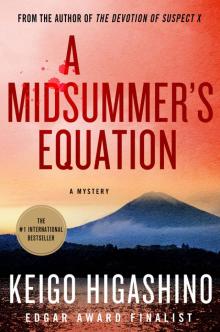 A Midsummer's Equation: A Detective Galileo Mystery
A Midsummer's Equation: A Detective Galileo Mystery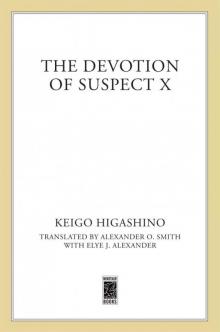 The Devotion of Suspect X
The Devotion of Suspect X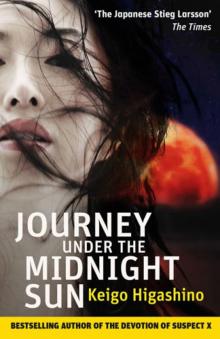 Journey Under the Midnight Sun
Journey Under the Midnight Sun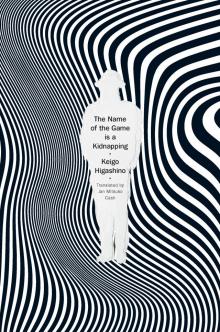 The Name of the Game Is a Kidnapping
The Name of the Game Is a Kidnapping Salvation of a Saint
Salvation of a Saint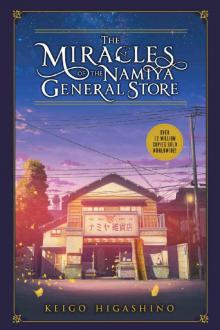 The Miracles of the Namiya General Store
The Miracles of the Namiya General Store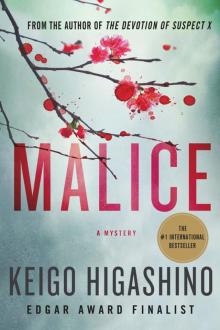 Malice: A Mystery
Malice: A Mystery